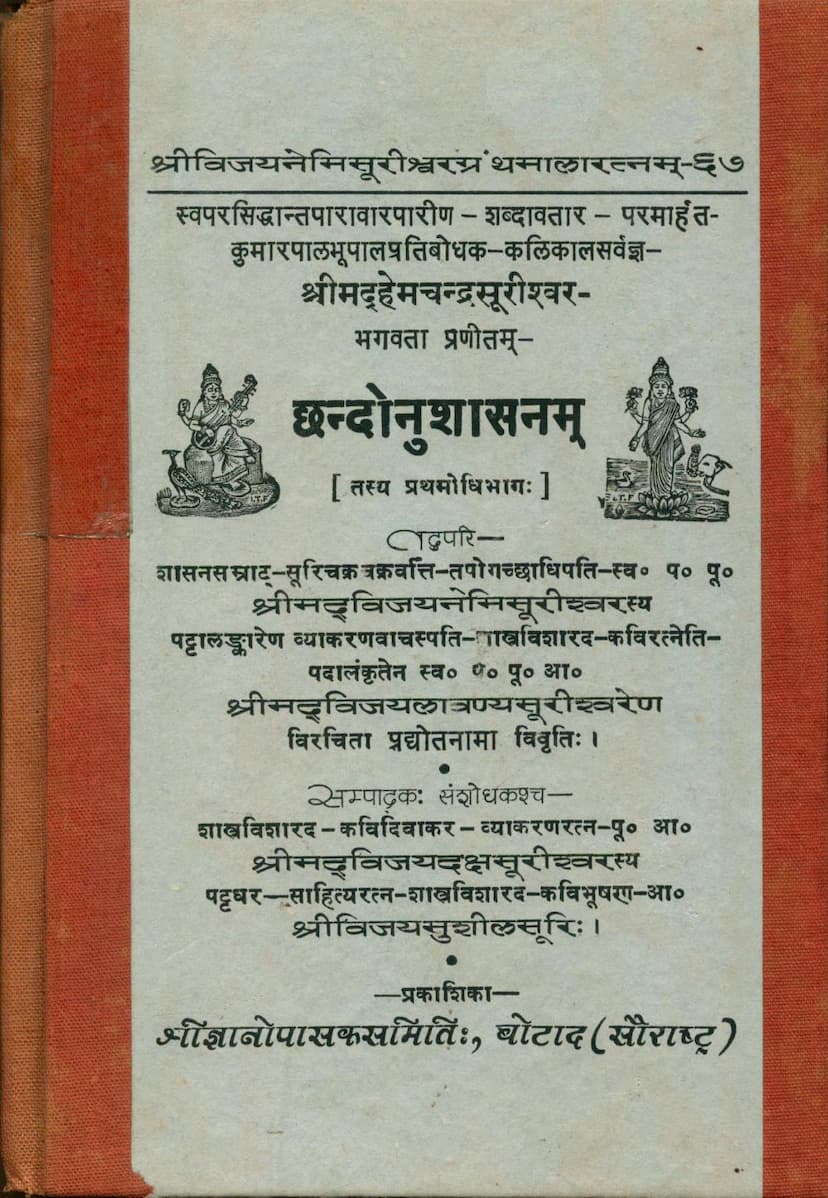Chandonushasan
Added to library: September 1, 2025

Summary
The provided text is the preface and initial pages of the Jain text "Chandonushasan" (छन्दोनुशासनम्), authored by the revered Jain Acharya Shrimad Hemchandracharya. The book is presented with a commentary (Vritti) named "Pradyota" (प्रद्योत) by the esteemed Acharya Shrimad Vijaylavanyasurishwarji, and it has been edited and compiled by Acharya Shrimad Vijaysushilsuriji.
Here's a comprehensive summary of the provided pages:
Book Details:
- Title: Chandonushasan (छन्दोनुशासनम्) - A Treatise on Prosody
- Original Author: Shrimad Hemchandracharya (the "Kalikal Sarvajna" - Omniscient of the Current Era)
- Commentary (Vritti): Pradyota (प्रद्योत)
- Commentator: Shrimad Vijaylavanyasurishwarji (a spiritual successor of the Tapagachha lineage and a prolific author)
- Editor & Researcher: Shrimad Vijaysushilsuriji (a successor of Acharya Shrimad Vijaydakshasurishwarji)
- Publisher: Shri Gyanopasak Samiti, Botad (Saurashtra)
- Book Series: Shri Vijay Nemisurishwar Granthamala Ratnam - 67
- Publication Year: Vikram Samvat 2025 / Veer Samvat 2494
Key Themes and Content:
-
Dedication: The monumental work, "Chandonushasan" with its Vritti, is dedicated with utmost respect and reverence to the lotus feet of Bhattaraka Acharya Maharajadhiraj Shrimad Vijay Nemisurishwarji, the "Shasan Samrat" (Emperor of the Faith) and "Surichakra Chakravarti" (King of the Ascetic Circle).
-
Context of the Commentary:
- The commentary "Pradyota" was composed by the late Shrimad Vijaylavanyasurishwarji. He is praised for his erudition in grammar, literature, and scriptures, his prolific writing (reportedly over seven lakh verses in Sanskrit), and his profound spiritual teachings.
- The editor and researcher, Shrimad Vijaysushilsuriji, is a disciple of Acharya Shrimad Vijaydakshasurishwarji and is also lauded for his mastery in scriptures, literature, and as a powerful orator. He has also contributed a preface to the work.
-
Significance of Prosody (Chhanda Shastra):
- The text highlights the importance of understanding prosody (Chhanda Shastra) for appreciating and composing poetry. It quotes a verse stating that while humanity is rare, knowledge is rarer, poetic ability is even rarer, and the power to create poetry is the rarest of all.
- It emphasizes that without knowledge of different meters (Chhanda Bhedas), one cannot properly read or compose metrical poetry.
- The text draws parallels with Vedic studies, where prosody is considered one of the six essential limbs of the Veda (Shadanga). It quotes a scriptural passage (Satapatha Brahmana) warning of dire consequences for those who chant Vedic mantras without proper knowledge of their meter, deity, and meter-related rules, implying potential downfall, misfortune, or even death. This underscores the meticulousness required in both Vedic and poetic compositions.
-
Etymology and Definition of "Chhanda":
- The text delves into the etymology of the word "Chhanda," discussing various interpretations, including "intention" or "purpose."
- A significant portion explores the derivation of "Chhanda" from the root "Chhad" (छादय्), meaning "to cover" or "to protect." This is linked to the idea that verses (Chhandas) protect the speaker or the essence from negative influences or errors. The commentary further debates whether "covering" implies concealment or a defining characteristic.
- It discusses how "Chhanda" relates to the regulation of syllables, sounds, and meters, providing a structure that defines and "covers" the poetic form.
-
Classification of Prosody:
- The text begins to classify different types of meters, mentioning the division into "Vritta" (वृत्त - based on syllable patterns) and "Jati" (जाति - based on syllabic quantity or pauses).
- It touches upon further categorizations based on Vedic and Laukika (secular) traditions, and also based on the primary unit of measure: Varnavritta (वर्णवृत्त - based on syllables) and Matravritta (मात्रावृत्त - based on duration).
- A point of discussion is raised about whether "Vritta" and "Chhanda" are synonyms or distinct, with some scholars differentiating them based on the fixed order of syllables versus the flexibility in metrical structure.
-
Gurus and Their Contributions:
- The text details the lineage of revered gurus, providing birth and death dates (V.S.) and significant life events for Acharya Shrimad Vijay Nemisurishwarji and Acharya Shrimad Vijaylavanyasurishwarji. This highlights the importance of the lineage and the contributions of these spiritual leaders.
- It also mentions Acharya Shrimad Vijaydakshasurishwarji and Acharya Shrimad Vijaysushilsuriji as key figures in the current publication.
-
Inaugural Verse (Mangalacharan): The text begins with an auspicious invocation to the Tirthankaras, specifically Lord Neminath (implied by the series title), praising their purity, omnipotence, and benevolent nature. The invocation sets a spiritual tone for the work.
-
The Author's Intent: Acharya Hemchandracharya, after composing the "Shabdānushasan" (Grammar) and "Kāvyanushasan" (Poetics), felt compelled to address prosody as a crucial component of poetry, thus leading to the composition of "Chandonushasan."
Overall Impression:
The initial pages establish the profound academic and spiritual lineage behind this publication. They emphasize the rigorous nature of Jain scholarship, particularly in linguistic and literary disciplines like grammar, poetics, and prosody, tracing back to the foundational teachings of the Tirthankaras and the meticulous work of revered Acharyas. The text is rich in philosophical discussion, etymological exploration, and historical context, setting the stage for a detailed exposition of Jain prosody.